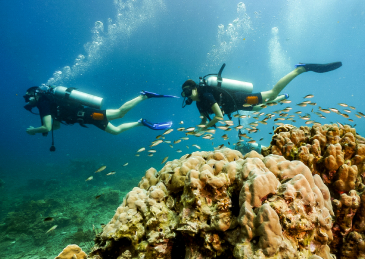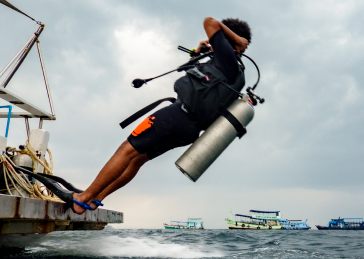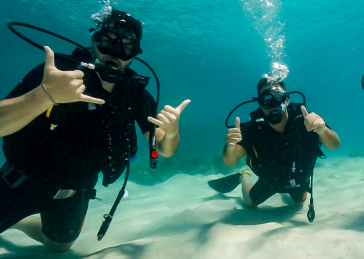Modified 3rd June 2025
Trevally Koh Tao: The Magnificent Silver Hunters Guide
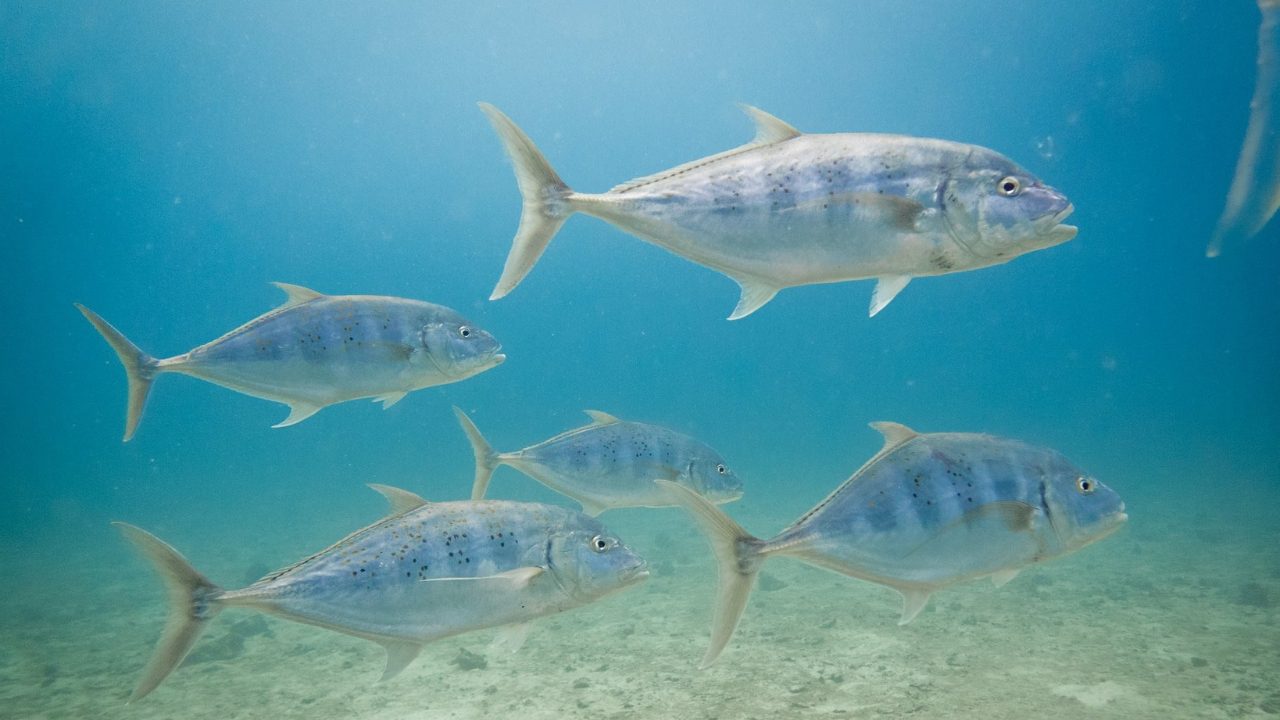
Among the diverse marine life surrounding Koh Tao, few fish command as much respect and admiration as the trevally. These streamlined, powerful members of the jack family (Carangidae) patrol the island’s waters with unmistakable confidence – making trevally Koh Tao encounters some of the most sought-after underwater experiences in Thailand.
Understanding trevally Koh Tao behavior patterns and habitats significantly enhances your diving experience around Thailand’s diving capital. These remarkable fish contribute significantly to the underwater spectacle that draws thousands of divers annually, with each trevally species fulfilling essential ecological roles in maintaining the delicate balance of coral reef ecosystems. To fully appreciate these encounters, understanding Koh Tao’s diverse marine life provides valuable context for trevally behavior and habitat preferences.
Trevally Koh Tao Species Comparison Guide
| Species | Size Range | Key Features | Best Locations | Behavior |
|---|---|---|---|---|
| Bluefin Trevally Caranx melampygus |
60-80 cm | Silvery-blue with dark spots, powerful build | Chumphon Pinnacle, Southwest Pinnacle, White Rock | Solitary or small groups, curious toward divers |
| Bigeye Trevally Caranx sexfasciatus |
60-90 cm | Large eyes, silver-blue, black gill spot | Sail Rock (massive schools), Chumphon Pinnacle | Spectacular schooling behavior |
| Golden Trevally Gnathanodon speciosus |
40-70 cm | Brilliant yellow-gold, pointed snout | Most dive sites, shallow reef areas | Associates with larger animals, cleaning behavior |
| Gold-spotted Trevally Carangoides fulvoguttatus |
50-70 cm | Silver with distinctive yellow spots | All dive sites, particularly reef territories | Small territorial groups, versatile feeding |
Interactive Dive Site Finder
Find the Best Sites for Your Target Trevally Species
Select your preferences to discover optimal diving locations and timing for trevally encounters:
The Bluefin Trevally: Powerful Predators
Perhaps the most visually striking of Koh Tao’s trevally species, Bluefin Trevally combine predatory power with remarkable beauty. Their silvery to bluish-gray coloration is overlaid with scattered dark spots, concentrated on the upper body.
Key Features:
- Laterally compressed, streamlined profile
- Slightly concave head profile
- Strong jaws for prey capture
- More intense coloration in juveniles
Bluefin Trevally display fascinating behavioral patterns combining solitary hunting with social interaction. They often form small hunting groups of 3-8 individuals when corralling schools of smaller fish.
Hunting Characteristics:
- Patrol reefs with apparent casualness
- Sudden acceleration bursts to intercept prey
- Most active during dawn and dusk
- Show curiosity toward divers
En Bigeye Trevally: Schooling Silver Shadows
Among Koh Tao’s impressive trevally lineup, the Bigeye Trevally stands out for its remarkable schooling behavior and distinctive large eyes – an adaptation enhancing vision in low-light conditions. Reaching 60-90 cm around Koh Tao, these impressive fish display predominantly silver to bluish-gray coloration with darker blue-black shading along the upper back.
Daily Activity Patterns of Bigeye Trevally
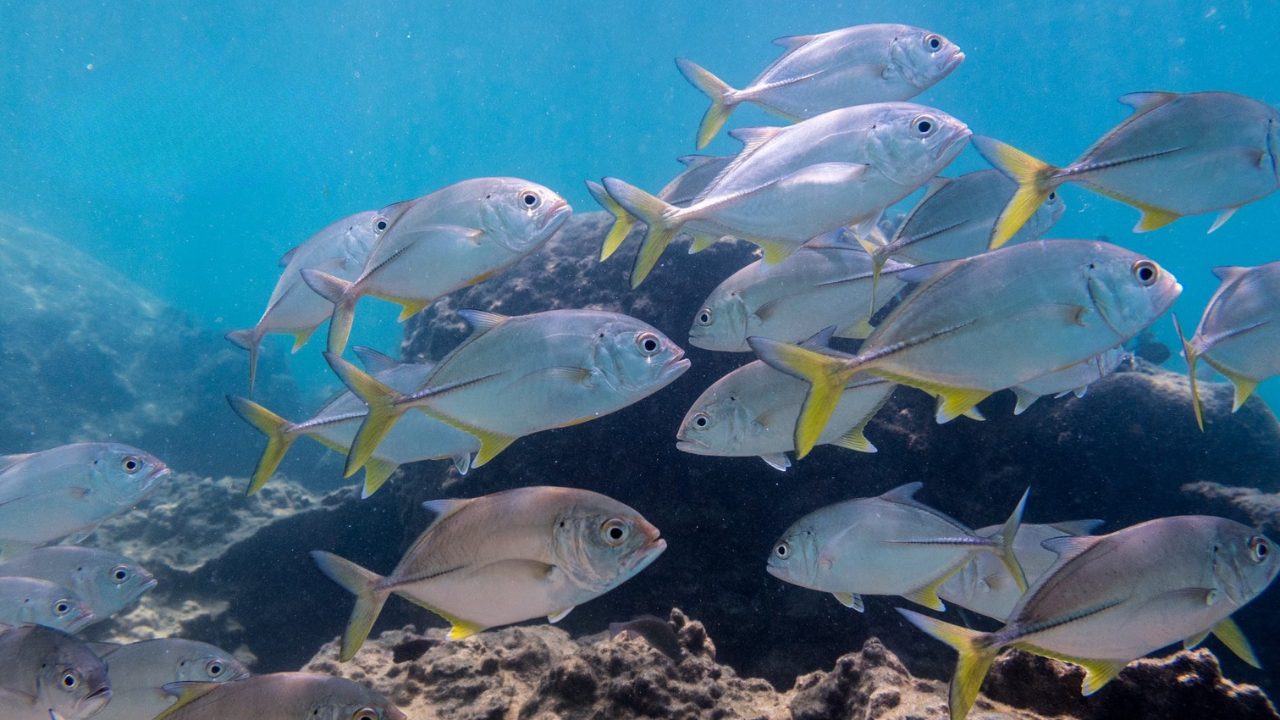
En Golden Trevally: The Midas Touch
Golden Trevally stand out for both their striking golden-yellow appearance and unique ecological relationships. Typically reaching 40-70 cm around Koh Tao, these beautiful fish combine predatory prowess with cleaning behaviors that create fascinating inter-species interactions.
Juveniles display brilliant yellow coloration with distinctive black vertical bands that fade as they mature. Their specialized pointed snout structure relates to their feeding strategies, allowing effective probing of sand and substrate for buried prey.
Interactive Trevally Identification Quiz
Test Your Trevally Knowledge
Can you identify these trevally species based on their characteristics? Test your underwater identification skills:
The Gold-spotted Trevally: Reef’s Spotted Sentinel
Completing Koh Tao’s diverse trevally lineup, the Gold-spotted Trevally adds a distinctively patterned member to the family. Instantly recognizable by their scattering of bright yellow to golden spots adorning silvery bodies, these elegant predators typically reach 50-70 cm around Koh Tao.
Their body profile is more elongated and less deeply compressed than other trevally species, giving them a sleeker appearance. The distinctive spotted pattern creates an almost jewel-like appearance, particularly when sunlight illuminates their flanks during shallow reef patrols.
Gold-spotted Trevally photographs beautifully when backlit by natural sunlight filtering through shallow water. Their spotted pattern becomes dramatically enhanced, creating stunning contrast against the blue water background. Best photography opportunities occur at sites with good natural lighting between 10-20 meters depth.
Best Trevally Koh Tao Viewing Times and Locations
Understanding when and where to encounter each trevally Koh Tao species significantly enhances your diving experience around Thailand’s premier diving destination. The March to September period generally provides more consistent trevally encounters, coinciding with calmer sea conditions that make offshore sites more accessible. For detailed seasonal information, check our guide on the best time to dive Koh Tao.
Prime Locations by Species:
- Bluefin Trevally: Chumphon Pinnacle, Southwest Pinnacle, White Rock, and Hin Pee Wee – particularly along edges where reef meets open water
- Bigeye Trevally: Sail Rock offers the most spectacular schooling displays, with Chumphon Pinnacle also providing excellent encounters
- Golden Trevally: Found at almost every dive site, particularly accessible to snorkelers in shallower reef areas
- Gold-spotted Trevally: Consistent residents at most dive sites, forming territorial groups around specific reef structures
Optimal Timing:
Early morning dives (6:30-8:00 AM) offer the highest probability of trevally Koh Tao sightings, particularly for Bluefin Trevally at deeper offshore sites. Bigeye Trevally schools are most spectacular during dawn and late afternoon transitions when their synchronized movements create the most dramatic underwater displays around Koh Tao’s pinnacles.
Despite their impressive adaptations, trevally species around Koh Tao face several conservation challenges including fishing pressure, habitat degradation from coral bleaching, tourism impact, and prey depletion. Their relatively slow growth and delayed sexual maturity make them vulnerable to overfishing.
Positive developments: Koh Tao’s status as a premier dive destination creates economic incentives for marine protection, with healthy fish populations far more valuable for sustained tourism than as fishing targets. Learn more about ongoing marine conservation efforts in Koh Tao.
When encountering trevally species, maintain respectful distances and avoid rapid movements that might disrupt their natural behaviors. Never attempt to touch or feed these wild predators. Flash photography should be used sparingly to avoid stressing schooling formations, particularly with Bigeye Trevally aggregations.
Ready to encounter these silver hunters in their natural habitat? La Bombona Diving offers expert-guided experiences to Koh Tao’s premier trevally viewing locations, with knowledgeable divemasters who understand these magnificent predators’ behaviors and habitats.
- Expert guides who know trevally behavior patterns
- Access to prime sites like Sail Rock and Chumphon Pinnacle
- Small group sizes for minimal impact on marine life
- Early morning departures for optimal sighting opportunities
- Professional underwater photography services available
- Multi-day packages for comprehensive trevally encounters
- Safety-first approach with experienced dive professionals
- Educational briefings about marine life identification
Sail Rock Day Trip – Perfect for Trevally Koh Tao Encounters: ฿2,800 including 2 dives at Thailand’s most famous pinnacle, with the highest probability of witnessing spectacular Bigeye Trevally tornado formations and other trevally species.
Book Your Sail Rock Trevally AdventureFull day trip | 2 dives | Transportation included | Departs 5:45 AM, returns 1:00 PM
Preguntas frecuentes
Photography and Observation Tips
Capturing or simply observing trevally species requires understanding their behavior patterns and respecting their natural movements. These powerful predators are sensitive to rapid changes in their environment, including the presence of divers.
Best Photography Practices:
- Approach slowly: Sudden movements will cause trevally to maintain greater distances
- Use natural light when possible: The metallic sheen of trevally is best captured with ambient lighting
- Focus on behavior: Hunting sequences and schooling formations make more dynamic images than static portraits
- Respect schooling fish: Avoid swimming through Bigeye Trevally schools – observe from the periphery
- Patience pays off: Trevally often circle back to investigate after initial encounters
Observation Guidelines:
The key to memorable trevally encounters lies in patient, respectful observation. These intelligent predators often display different behaviors when divers remain calm and predictable in their movements. Bluefin Trevally, in particular, may approach quite closely if divers avoid rapid movements or direct pursuit.
Ecological Importance
Trevally species serve as crucial apex predators in Koh Tao’s marine ecosystems, helping maintain the balance of smaller fish populations. Their presence indicates healthy reef systems, as these predators require abundant prey and clean water conditions to thrive. To understand their role within the broader ecosystem, explore our comprehensive guide to marine life around Koh Tao.
As predators of smaller reef fish, trevally help prevent overgrazing of algae-eating fish, indirectly supporting coral health. Their hunting activities also redistribute nutrients throughout the reef system, contributing to overall ecosystem productivity.
The economic value of healthy trevally populations extends far beyond their intrinsic ecological worth. These magnificent fish represent one of the primary attractions drawing thousands of divers to Koh Tao annually, supporting local tourism economies while providing living proof that marine conservation efforts create lasting benefits for both wildlife and human communities.
Future Conservation Efforts
Protecting trevally Koh Tao populations requires continued commitment to marine conservation initiatives. Current efforts include:
- Marine Protected Areas: Expanding no-take zones around critical habitat areas
- Monitoring Programs: Regular population surveys tracking trevally abundance and distribution
- Education Initiatives: Teaching visitors and locals about the importance of predatory fish
- Sustainable Tourism: Promoting responsible diving practices that minimize wildlife disturbance
- Research Collaboration: Supporting scientific studies on trevally behavior and ecology
The future of these magnificent silver hunters depends on continued cooperation between dive operators, tourists, researchers, and local communities. Every respectful trevally Koh Tao encounter contributes to a growing understanding of these remarkable predators while supporting the economic incentives that make their protection possible.
By choosing responsible dive operators and following established guidelines for marine life observation, visitors to Koh Tao become part of the conservation solution, ensuring that future generations will continue to experience the thrill of trevally Koh Tao encounters in their natural habitat.
Bucea con LBD: tu puerta a la exploración submarina
Whether you’re a curious beginner or a seasoned pro, our school is your portal to the wonders of scuba diving. Join us into the world beneath the waves.
¿LISTO PARA EMPEZAR?
Consulta nuestros cursos de buceo en Koh Tao
